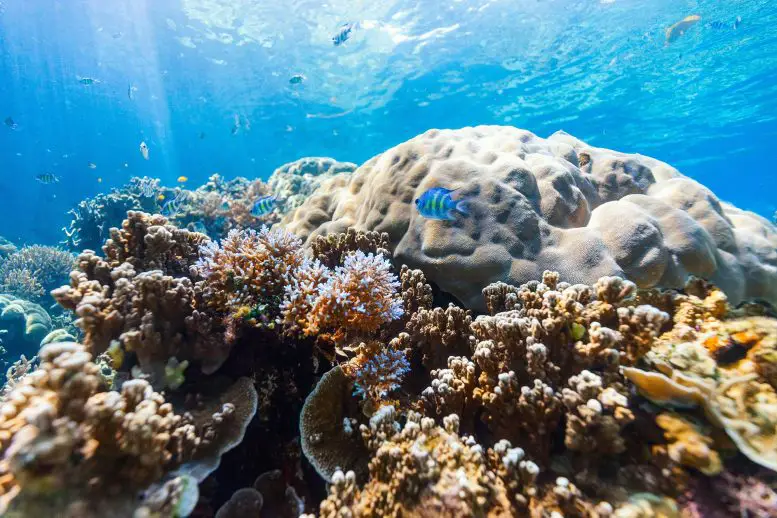The complex structure of coral reefs creates a vibrant underwater ecosystem where life is in full swing. Ironically, this same complexity can prevent corals from recovering from disturbances, as researchers studying reefs in Moorea, French Polynesia, found.
network of coral skeletons
Experts have found that the network of dead coral skeletons left behind by bleaching disrupts critical processes that prevent reefs from recovering. These dead structures protect the seaweed from herbivores, allowing them to quickly colonize and destroy young corals.
The research findings, published in the journal Global Change Biology, highlight how the effects of disturbances can alter the course of reef recovery.
Coral reef degradation
Coral reefs are dynamic systems that are constantly changing, and disturbances such as storms, coral destruction or coral bleaching can significantly affect their condition. Historically, tropical storms and hurricanes have caused the most damage to Moorea’s reefs.
“They tend to scrape off all the coral on the reef, leaving a flat surface behind,” says Kai Kopetsky, lead author of the study and a former postdoctoral researcher in UC Santa Barbara’s Department of Ecology, Evolution and Marine Biology.
However, recently, events such as coral bleaching and predation have been increasingly observed. Unlike storms that physically remove corals, bleaching leaves reef skeletons intact.
Discoloration and other stress factors
Bleaching occurs when stress, usually from heat, causes corals to expel the symbiotic algae that provide them with nutrients. Although corals can sometimes recover if favorable conditions are restored, most often the colony dies, especially if other stressors such as pollution are present.
For example, in 2010, a powerful hurricane hit the Moorea reef and destroyed almost all the coral in the front reef. “But within about five years, the reef reached the amount of coral it had before the storm,” Kopetsky said. But after whitening in 2019, Kopetsky and his team observed a completely different result.
The dead coral structure remained, but instead of recovering, the reef continued to shrink and seaweed (macroalgae) began to grow. Kopecki wanted to understand how these different perturbations affected the reef’s recovery.
Modeling the reef system
To investigate this, researchers conducted an experiment as part of their work at the Long Term Environmental Research (LTER) facility on Moorea’s coral reefs. The aim was to analyze the processes disrupted after bleaching. In 2023, scientists developed a mathematical model of the reef system, while field research focused on examining the underlying mechanisms.
The research team cleared small areas of the reef to create experimental areas. They created a controlled amount of dead coral skeleton in these areas and periodically added young, healthy corals that could be removed and measured. Macroalgae trays were also placed on the reef to compare how herbivores interact with algae in the presence of dead coral skeletons and in open areas.
Coral skeletons limit new growth
“We found that the skeletons of dead corals prevent herbivores from destroying macroalgae, allowing growth and preventing new corals from settling and surviving on the reefs,” explains Kopecky.
In theory, these skeletons could provide some protection to young corals if they appear shortly after bleaching. Unfortunately, corals tend to spawn only once a year, while algae reproduce continuously, giving the algae the advantage of colonizing new empty spaces.
Competition for resources
Macroalgae compete directly with corals for resources such as space and light. Algae grow much faster than corals, so when herbivores cannot control algae growth, algae can quickly take over the reef. This prevents new corals from colonizing and even obscures existing colonies, making restoration difficult.
Young corals are particularly vulnerable to this competition, and when a reef moves from coral to algae dominated, it is very difficult to reverse this process. Previous studies by scientists have shown how difficult it is to restore coral cover after such a change.
Key differences in reef recovery
Comparing the results of their experiments with years of data from Moorea, the researchers noted sharp differences in the recovery of reefs after different types of disturbances.
“After the cyclone, coral cover on the reefs increased, while macroalgae cover decreased,” Kopecky said. he said. “After bleaching, everything turned around.”
These findings fit into the broader concept of ecological memory, which examines how past events shape an ecosystem’s response to current challenges. As the nature of disturbances changes, so does the way ecosystems, such as coral reefs, respond.
“As these disturbance regimes change, ecological memory also changes,” Kopecky says.
Removing coral skeletons
Unfortunately, the legacy of dead coral skeletons may not match what these ecosystems are adapted to, potentially altering long-standing relationships between corals, algae, and herbivores. Kopetsky now wonders whether removing dead skeletons could help corals recover, or at least reduce the negative effects of bleaching.
“This is a new idea and strategy for coral reefs. But if you look at other ecosystems (such as prescribed burning of forests to remove dead wood), people are increasingly thinking about manipulating dead matter in ecosystems for management purposes.”













